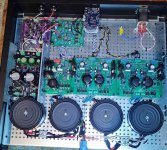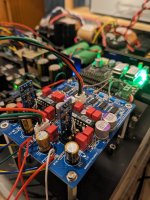Just found that reclock is done by Xilinx inside of Jlsound card. Then probably external clock can improve quality.
You can also get the V2 Jlsound and enjoy proper reclocking
Cost Grunf/Vunce AD811 only for parts is 150 Euros. Cost for Burson V6 classic is 80 euros with shipping (already bought). Is Ad811 realy so much better to pay it twice more? Or maybe if there is tube I/V which is better than both.
Personally, I like the combination of AD1862 + Sparkos SS3601 or Burson V5 better than Burson V6 Classic. Maybe it's better to take the Burson V6 Vivid, but I don't have that one, so I can't confirm that it's a good match.
V6 Classic is a good match for PCM63.
And I am convinced that Tesla's problems with JLS are only related to weak power from the USB port.
V6 Classic is a good match for PCM63.
And I am convinced that Tesla's problems with JLS are only related to weak power from the USB port.
Last edited:
You can make your own version of AD811 then the parts should not be more expensive than 40 euros, I have a PDF of the PCB if you can make it at home. The power supply can remain as is, so you can upgrade it later.Cost Grunf/Vunce AD811 only for parts is 150 Euros. Cost for Burson V6 classic is 80 euros with shipping (already bought). Is Ad811 realy so much better to pay it twice more? Or maybe if there is tube I/V which is better than both.
Otherwise, the power supply has the most space for improvement but as far as I can see no one dares to take a big step there and switch everything to shunt regulators.
I still don't know exactly which is the best I/V (after all, this is a hobby that has no end), but AD811 is currently number one for me. Is it possible to get something like that with tubes? I think no. Maybe some discrete I/V but among op amps for I/V I would always put the AD811 in first place.
Honestly no one can tell you except for your ears 🙂 They all play solid (granted objectively some better than others), but in the end it's the taste in subtleties which differentiate whats better for you. To get to the point where you want to have figured it out, you have to pay certain amount, build it all and keep whats best for you specifically. No experience comes without expense 🙂
Depending how is complicate pcb. Anyway please send me PDF on PM.You can make your own version of AD811 then the parts should not be more expensive than 40 euros, I have a PDF of the PCB if you can make it at home. The power supply can remain as is, so you can upgrade it later.
Otherwise, the power supply has the most space for improvement but as far as I can see no one dares to take a big step there and switch everything to shunt regulators.
I still don't know exactly which is the best I/V (after all, this is a hobby that has no end), but AD811 is currently number one for me. Is it possible to get something like that with tubes? I think no. Maybe some discrete I/V but among op amps for I/V I would always put the AD811 in first place.
Thx
I'm reporting back on my personal findings with my Miro AD1862 DACs.
- I built two copies of Miros DAC with identical PSUs (studer 900 clones).
- The first copy (Miro A) used a waveIO usb to I2S input with its own separate PSU and shift registers, I tried a few opamps that I had on hand but found that I prefered a Sparkos descrete opamp by far over the ones that I tried. This copy sounds very good.
- The second copy (MiroB) used identical PSUs and used a JLSounds usb to I2S input with separate PSUs. This copy bypassed the shift registers and used the JLSounds to send 20 bit input directly to the DAC. I also tried and liked Sparkos opamps with this build.
- I thought that MiroB sounded a bit better than MiroA. MiroA seemed more diffuse, less forward in comparison. MiroB more forward, but better dynamics seemed more intense. One could stop here and get very nice sound.
- I just completed adding Abraxilitos Dark IV to Miro B. I used a Salas ultra BIB shunt psu for the IV. This gave a big upgrade in sound over the other configurations. Improved soundstage, better dynamics, more clarity and detail, more impactful and powerful bass. The sense of realism is improved and easily heard over the other builds. This build easily becomes my reference DAC, really excellent sound. See the attached pic of the MiroB build.
- I still working to complete my CEN IV (for me a tough build) to try it out, When I'm done I'll install it in MiroA when I'm done and report my findings here.
- I built two copies of Miros DAC with identical PSUs (studer 900 clones).
- The first copy (Miro A) used a waveIO usb to I2S input with its own separate PSU and shift registers, I tried a few opamps that I had on hand but found that I prefered a Sparkos descrete opamp by far over the ones that I tried. This copy sounds very good.
- The second copy (MiroB) used identical PSUs and used a JLSounds usb to I2S input with separate PSUs. This copy bypassed the shift registers and used the JLSounds to send 20 bit input directly to the DAC. I also tried and liked Sparkos opamps with this build.
- I thought that MiroB sounded a bit better than MiroA. MiroA seemed more diffuse, less forward in comparison. MiroB more forward, but better dynamics seemed more intense. One could stop here and get very nice sound.
- I just completed adding Abraxilitos Dark IV to Miro B. I used a Salas ultra BIB shunt psu for the IV. This gave a big upgrade in sound over the other configurations. Improved soundstage, better dynamics, more clarity and detail, more impactful and powerful bass. The sense of realism is improved and easily heard over the other builds. This build easily becomes my reference DAC, really excellent sound. See the attached pic of the MiroB build.
- I still working to complete my CEN IV (for me a tough build) to try it out, When I'm done I'll install it in MiroA when I'm done and report my findings here.
Attachments
That's right, it sounds better without shift registers, but you're doomed to only a JLS board and a USB input. If you want something else, say SPDIF and TOSLINK, Amanero, WaveIO and the like, you have to use shift registers. So I will probably end up with two DACs, one with a lot of inputs and an AK 4118 receiver board (AD1862) and the other with only USB and PCM63. That second one will also get a tube output stage. So the ultimate approach for PCM63 and compromise for AD1862.
https://www.aliexpress.com/item/100...order_list.order_list_main.104.21ef1802brNKD7
If anyone needs it, I tried it and it works. The display is small, but it suits me for a small DAC. Consumption max. 150mA & 5VDC.
If anyone needs it, I tried it and it works. The display is small, but it suits me for a small DAC. Consumption max. 150mA & 5VDC.
The 150 Euros also include the shunt PSU on the board.Cost Grunf/Vunce AD811 only for parts is 150 Euros. Cost for Burson V6 classic is 80 euros with shipping (already bought). Is Ad811 realy so much better to pay it twice more? Or maybe if there is tube I/V which is better than both.
Hi PJN, I also have Abraxilito's Dark IV with +-15v.
Now I am playing with opamp.
Are there anything to take out from DAC PCB?
I am thinking to take opamp 2 for + 3 for gnd to Dark IV.
Now I am playing with opamp.
Are there anything to take out from DAC PCB?
I am thinking to take opamp 2 for + 3 for gnd to Dark IV.
If you want to build streamer together with dac, based on Raspberry, this IPS display is very good option
https://community.volumio.com/t/diy-streamer-with-r2r-dac-8-8-display/57656
https://community.volumio.com/t/diy-streamer-with-r2r-dac-8-8-display/57656
You also need to remove Riv(r8,r9) and Civ if you have them installed. I out to IV is from pin 2 on opamps , and from pin 3Hi PJN, I also have Abraxilito's Dark IV with +-15v.
Now I am playing with opamp.
Are there anything to take out from DAC PCB?
I am thinking to take opamp 2 for + 3 for gnd to Dark IV.
- Home
- Source & Line
- Digital Line Level
- DAC AD1862: Almost THT, I2S input, NOS, R-2R


